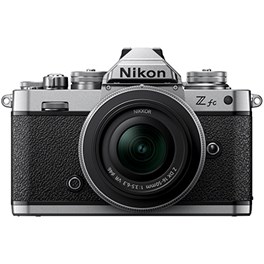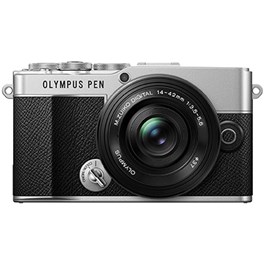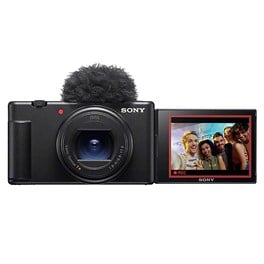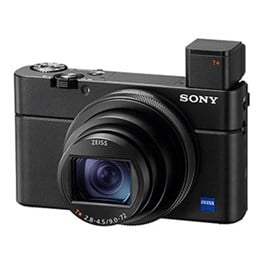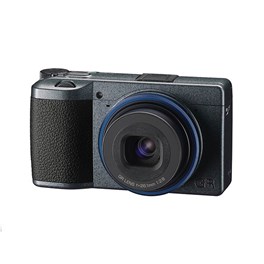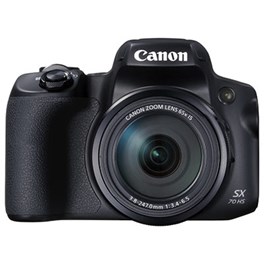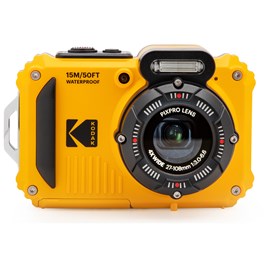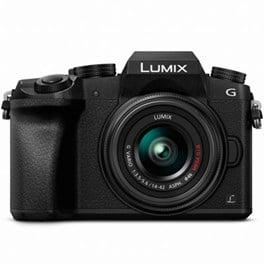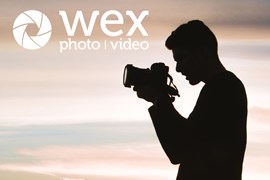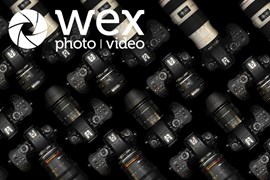
Travel and lifestyle influencers in 2024, have to wear many hats, and as such you’ll need a camera that can keep up. It’s no longer enough to be able to snap a pretty picture of a flat lay – being an influencer nowadays means being equally adept at producing not just appealing photography, but also great-looking (and great-sounding video). You’ll want to be able to achieve all this with a single camera, one that doesn’t cost too much, and ideally one that has a bit of style to it, both in terms of looks and the images it produces.
You can of course use your phone for this – and many influencers do, we’re not pretending otherwise. However, using a dedicated camera will confer all sorts of advantages in terms of your ability to produce great-looking content for Instagram, TikTok, YouTube and, uh, Threads. (Are people still on Threads? Disregard this part if everyone has already forgotten about Threads by the time this blog goes live.)
With a larger sensor and the ability to use sharper, more optically sophisticated lenses, cameras will produce significantly better image quality in a range of lighting conditions. Battery life is generally better (owing in part to the fact that you can’t also use them for scrolling), cameras have a wider range of photo/video accessories, and the form factor of a camera makes it more comfortable and practical to use for extended shoots.
There are plenty of different types of camera worth considering for influencers. Many will likely be tempted by a smaller mirrorless camera, offering interchangeable lenses and a high-end video spec. However, it’s also worth considering a DSLR, with a rugged build and generous battery life. The all-in-one convenience of a compact camera or bridge camera is also hugely useful for travel, as there’s no need to worry about packing multiple lenses. And finally, there are plenty of great budget cameras for those who don’t have a lot to spend.
We’ve covered all these categories in this guide, so let’s get right into it.
Quick Navigation
Best Mirrorless Camera
Agile, versatile and supremely capable in both video and stills – mirrorless cameras have a heck of a lot to offer to aspiring influencers. And established ones for that matter; if you’ve been getting by with your phone but have an urge to graduate up to a full camera, a mirrorless system is a good place to start. All the major manufacturers now have well-established, flagship mirrorless systems with loads of mid-priced and budget-friendly options to suit online content creators.
We’ve focused on mid-range mirrorless models here – most content creators don’t need the high-end features of professional cameras, but also probably want something a bit more advanced than an ultra-beginner model. We’ve made sure to include mirrorless cameras that are equally capable for photos and videos. And it doesn’t hurt that these are some of the most stylish mirrorless cameras you can buy, too.
Nikon Z fc Digital Camera with 16-50mm Lens
Combining classic operational and physical attributes with high-powered and versatile modern technology - The Nikon Z fc Digital Camera Body is Nikon’s first Z-series camera to wear a ‘heritage’ design that is inspired by the iconic Nikon FM2 SLR film camera from 1982. This camera is compact, lightweight and highly versatile with a powerful DX APS-C 21-megapixel image sensor and EXPEED 6 processing engine. Amongst its classic design features, such as a circular eyepiece for the EVF, the Z fc is equipped with powerful modern features that are both intuitive and make for flexible shooting aimed at both existing and first-time mirrorless camera users. This includes the effective Eye-Detection & Animal-Detection AF in both video and stills that was first seen in Nikon’s Z 7 II and Nikon Z 6 II cameras and the inclusion of the first vari-angle monitor among the Z-series. This kit includes the super-compact and high-quality Nikon Z 16-50mm f3.5-6.3 DX VR Lens.
£1,089.00 View
Pros:
- Adept at switching between photo and video
- Stylish, analogue-esque design
- Excellent uncropped 4K video
Cons:
- No AF-point selection joystick
- No built-in stabilisation
There’s no shame in appreciating style. For many influencers, a good-looking camera can be an important character in their ongoing story, and the Nikon Z fc is a beautiful-looking mirrorless shooter. Its design hearkens back to the days of film SLRs, but on the inside, it’s all modern, baby. It’s equally adept at stills and video, and in a sensible design touch, has separate settings banks for both, making it easy to switch from one to the other.
The UHD 4K at 30p looks fantastic, and is complemented by other aspects of the camera. The fully articulating screen combined with Eye Detect autofocus makes it easy to use the Z fc for filming yourself, and there’s also a 3.5mm microphone socket for professional-quality audio. Lens-wise, the Z fc can be bought in a bundle with the versatile Z 16-50mm f3.5-6.3 DX VR Lens – a useful choice as it adds Vibration Reduction (VR) stabilisation, a feature the Z fc itself lacks.
Olympus PEN E-P7 Digital Camera with 14-42mm Lens - Silver
By blending classical styling with contemporary optical features, the Olympus PEN E-P7 with 14-42mm lens stands as an exciting creative tool for on-the-go image-makers. With an integrated 20MP Live MOS sensor and high-powered TruePic VIII image processor, this Micro Four Thirds camera system has the capacity to create visually stunning images at the press of a button. You are further afforded stunning 4K quality video, in-body 5-axis stabilisation, high-functioning continuous AF, and Face Priority/Eye Priority AF. The included Olympus 14-42mm f3.5-5.6 EZ M.ZUIKO lens perfectly complements the PEN E-P7 in both style and performance; delivering crisp, edge-to-edge quality throughout the entire zoom range. For quick-action photo transfers, the PEN E-P7 also has in-built WiFi and Bluetooth connectivity, as well as direct access to the intuitive OI.Share app.
£849.00 View
Pros:
- Gorgeous looks
- 180-degree tilting screen
- Profile Control dial enables quick access to stylish colour modes
Cons:
- No viewfinder
- Contrast-detect autofocus
Another camera with style to spare, the Olympus PEN E-P7 is a Micro Four Thirds mirrorless model that’s tinged with retro cool. With a 180-degree tilting screen, it’s brilliant for vlogging, and the 20.3MP Four Thirds imaging sensor produces excellent quality in stills and video alike. The 5-axis optical stabilisation is very good as well, delivering four stops of effective compensation for smoother footage and sharper pictures.
One aspect of the Pen EP-7 we particularly love – and one that’s likely to appeal to lifestyle influencers – is the Profile Control switch, which allows you to effortlessly summon stylish colour and monochrome profiles at the touch of a button. These bespoke profiles are the closest thing you’ll get to Fujifilm’s FIlm Simulation modes outside of the Fujifilm system. We particularly like Mono 2, which analogue enthusiasts will probably clock is a loving tribute to Kodak’s high-contrast Tri-X film stock.
Pros:
- Small, sleek, stylish body
- Excellent built-in stabilisation
- Beautiful quality in stills and video
Cons:
- No weather-proofing
- Fewer physical controls than other Fujifilm bodies
While the newer Fujifilm X-S20 has recently arrived and stolen the limelight, the small but mighty X-S10 is still widely available, comes at a cheaper price, and still does everything most influencers are likely to need it to. It produces gorgeous, vibrant, puncy images, replete with those to-die-for Fujifilm colours, and you also get access to the fun selection of Film Simulation modes to give your images an analogue look. Also, shout-out to Fujifilm for fitting such an effective IBIS (in-body image stabilisation) system into a body this small.
Video-wise, the X-S10 is also thoroughly kitted out, with uncropped 4K 30p available, as well as the option to shoot Full HD at up to 240p for super-slow-motion effects (though be aware the resulting footage is pretty noisy). It looks the part too – while there aren’t as many physical control dials as other Fujifilm bodies, the oveall design has bags of style to it.
Best DSLR Camera
DSLRs may not be quite as chic as the trendy mirrorless models we selected for the previous section, but there’s something to be said for a workhorse camera that just gets the job done. Also, the latter years of DSLRs saw some impressive advancement in terms of video capability, so while the models we’ve selected for this section are excellent stills-shooters, they’ll ably cope with the demands of moving pictures, too.
If you’re someone who just can’t imagine shooting without a viewfinder pressed to your eye, a DSLR is a good bet. You’ll also have lots of lenses to choose from (one of the benefits of choosing an older system), and not necessarily having to rely on an LCD screen of any sort to compose images can really help with extending battery life.
Canon EOS 90D Digital SLR Camera Body
The Canon EOS 90D comes as the upgrade to the popular Canon 80D. The 80D became a go to camera for both professionals and amateurs because it was such a versatile system, so this upgrade is sure to impress any level of photographer. It features a larger 32.5 megapixels APS-C imaging sensor that will produce some incredible detailed photographs and video footage. Like the 80D, the 90D has been designed for speed; catering to sports and wildlife photographers - Or anyone who has fast moving subjects. It's also capable or capturing some stunning 4K footage and of course, features Canon's EF-S mount, meaning there are a huge range of compatible lenses for you to choose from. Take a look at the impressive list of features this camera has!
£1,299.00 View
Pros:
- Lots of lenses available
- Generous battery life
- Well-featured for video
Cons:
- Screen not the brightest
- Price tag higher than many APS-C alternatives
Now that mirrorless cameras are so dominant in the video space, DSLRs can be somewhat overlooked for their vlogging and video capabilities. However, there have been plenty of DSLRs that have really delivered on the promise of a true hybrid photo/video camera, arguably the most successful of these being the Canon EOS 90D.
Review the specs for more than a few minutes and you start to notice the extent to which this camera is pitched towards vloggers. There’s the fully articulating screen that can be flipped to face forwards, the two 3.5mm jacks for both microphones and headphones. There’s also the 4K 30p video resolution – not as high as the resolutions you’ll see on cameras that have come out since 2019, but realistically just fine for most purposes.
It is of course a superb stills camera too, with a respectable 10fps burst rate, reliable autofocus tracking and generous 32.5MP resolution. The large range of Canon EF-S lenses doesn’t hurt either.
Pros:
- Easy to learn to use
- Vari-angle touchscreen and optical viewfinder
- Excellent Live View autofocus
Cons:
- No weatherproofing
- 4K is cropped, and doesn't get Dual Pixel AF
The Canon EOS 250D has been hailed by many, including us, as one of the best beginner DSLRs ever made. If you’re near the beginning of your career and are still getting to grips with the basics of image-making, it’s definitely one worth considering. The UI is one of the most user-friendly in the business, with Creative Assist and Guide modes designed to help you wrap your head around how to get a great shot. Any camera can capture a competent image in Auto mode, but the EOS 250D actually teaches you how to do it.
With an APS-C sensor and an impressive autofocus system, the EOS 250D isn’t just a starter camera, and is more than capable of producing top-quality images. It has 4K video too, though be warned this mode is somewhat compromised. Shooting 4K comes with a vicious 1.6x crop, and also means you can’t use the excellent Dual Pixel CMOS autofocus system.
Best Compact Camera
For style and simplicity, there’s a lot to be said for a compact camera. While they aren’t as numerous as they once were, compacts with fixed lenses still have their place in the worlds of photo and video alike, and we’ve selected options here to cover either or both of those remits.
A compact camera provides convenience and value for money, with the trade-off that you’re working within narrower confines than you would be with an interchangeable-lens system camera – the lens you have is the one you’re stuck with, that’s it.. Some compact cameras offer zoom lenses with a flexible focal range, while others use prime lenses with a fixed perspective (the trade-off there being improved sharpness and sometimes a faster maximum aperture). We’ve included both types in this section of the guide.
Sony ZV-1 II Digital Camera
Sony continues to put users at the centre of all they do by introducing the ZV-1 II compact digital camera. Taking feedback from original ZV-1 users and reinventing their concept to streamline the Sony vlogging experience, the ZV-1 II comes equipped with a wider 18-50mm f1.8-4.0 lens, Cinematic Vlog settings, an upgraded 3-capsule mic with customisable directivity, and more intuitive touch controls.
£769.00 inc. Cashback View
Pros:
- Useful wide zoom lens
- Impressive 3-capsule microphone
- Autofocus is consistently excellent
Cons:
- Video focus means no viewfinder
- Aperture drops sharply at long end of lens
For most influencers, it’s unlikely you’re shooting stills and video in an even 50/50 split. You may be someone who mostly takes photographs, but throws a little video in there now and again. Or, you may be someone who’s mostly video, but appreciates the option to capture stills when needed. The Sony ZV-1 II is designed for those in the latter category – while it does capture stills and do so pretty well, it’s a vlogging camera first and foremost.
It’s got a lens that can widen out to a vlog-friendly 18mm. It’s got a built-in ND filter to control the light intake by up to three stops. It offers Cinematic Vlog adjustable presets to automatically give your footage a cinema-like look and feel. Its autofocus system is absolutely superb in both stills and video, with AI-powered subject recognition that can lock onto specific subjects like humans and animals, as well as Sony’s famous Eye AF.
Sony Cyber-Shot RX100 VII Digital Camera
The RX100 VII from Sony is an ideal point-and-shoot camera for serious photographers. Featuring a 1.0-type stacked 20.1MP Exmor RS CMOS sensor, a 24-200mm f/2.8-4.5 Zeiss Vario-Tessar fixed lens, and a single burst shooting drive mode that allows users to capture up to 90 sequential images per second. Video users are also catered for with the RX100 VII featuring 4K and HDR video, with Real-Time Tracking and Real-Time Eye AF. 257-point focal-plane phase-detection AF points, and 425-point contrast AF make it the fastest performing autofocus system in the world for a camera of its type.
£949.00 inc. Cashback View
Pros:
- Lens is sharp throughout (long) zoom range
- Incredibly capable for such a small camera
- Autofocus is particularly good
Cons:
- So small it can be fiddly to use
- Not the best battery life
Sony’s RX100 series has been a seven-part answer to the question: how good a camera can we get into the smallest possible body? And while the Mark VII is undeniably expensive for a 1-inch sensor compact, you really do get a lot for your money. The star of the show is the 24-200mm f/2.8-4.5 Zeiss Vario-Tessar fixed lens, a sensational piece of optical engineering that delivers the goods right the way through that big old zoom range. As a travel and lifestyle shooter, it’s unlikely you’re going to need to stray outside of that range very often – and that’s from a camera that fits in your pocket.
Small cameras aren't for everyone – some people simply find them too fiddly. If that sounds like you then you aren’t going to want anything to do with the RX100 VII, as its tiny buttons and miniature pop-up viewfinder can make for a tricksy control experience.
Ricoh GR IIIx Digital Camera Urban Edition
Designed to reflect urban surroundings, the Ricoh GR IIIx Digital Camera Urban Edition is the ultimate tool for street photography. This new version of the GR IIIx sports a unique body that offers excellent grip and oozes with style. It also comes with a suite of special functions, including a new exposure mode for faster shooting, an additional Auto-area AF (Center) setting, and more.
£1,099.00 View
Pros:
- Stylish, pocketable, all-in-one body
- Genuinely enjoyable to use
- Excellent image quality
Cons:
- Fixed focal length reduces versatility
- No 4K video
A hugely popular camera among influencers and influencers alike is the Fujifilm X100V – so popular, in fact, that it was sold out of stock for most of its run. It has now been surpassed by the X100VI, but that's beside the point. If you like the sound of a chic, all-in-one, street-shooting compact camera, a great option that is similar is the Ricoh GR IIIx.
Pairing an APS-C sensor with a fixed 40mm equivalent lens, the GR IIIx is a pocketable companion that delivers tremendous image quality wrapped up in a stylish body. It produces razor-sharp stills at a broad range of ISO settings, and has a variety of snappy focus settings for nailing the shot quickly and efficiently. An effective stabilisation system also helps keep shots sharp at slower shutter speeds.
The GR IIIx is less well-optimised for video – it produces great-looking Full HD footage at 60p, but no 4K, and being restricted to a 40mm perspective may not suit the kind of content you want to create.
Best Bridge Camera
A big old bridge camera is a less fashionable choice than it once was, but given that they’re particularly useful for travel, we’d be remiss if we didn’t provide a few recommendations. A bridge camera is a particular type of compact camera, with two important distinctions.
The first is DSLR styling; with their nice chunky handgrips, many bridge cameras could easily be mistaken for DSLRs at a glance. The second (and arguably more important) distinction is that bridge cameras have big superzoom lenses. It’s common for a bridge camera to be able to zoom from a wide perspective of around 25mm or so to a super-telephoto focal length like 400mm or even more, and this naturally makes them extremely versatile. To get the equivalent kind of coverage on an interchangeable-lens system, you’d generally have to pay significantly more than the asking price of most bridge cameras.
- Sharp, Leica-made 16x zoom lens
- Suite of 4K video features
- On-the-go USB charging
- No weatherproofing
- Micro USB not USB-C
A very plush bridge camera indeed, the Panasonic Lumix FZ1000 II is a welcome reminder that this format can deliver a premium shooter. Pairing a 20.1MP 1-inch sensor with a 25-400mm Leica F2.8-4.0 DC lens, the FZ1000 II boasts a fearsome imaging combination, resulting in exactly the kind of shooting versatility that people are looking for in a bridge camera.
As a Panasonic Lumix camera, it also boasts a raft of excellent 4K video features, as well as Panasonic’s 4K Photo modes that allow for the extraction of high-quality stills from 4K footage. An “Auto Marking” feature helps you pick the best still from footage you’ve captured at the maximum frame rate of 30fps – useful if time is of the essence.
If you’ve got a bit more pocket change and value premium style, consider also the Leica V-LUX 5. It’s essentially the same proposition as the FZ1000 II, only with a premium Leica-designed body, and of course, the iconic red dot.
Canon PowerShot SX70 HS Digital Camera
The Canon PowerShot SX70 HS is pack of Canon's SX-series of super-zooms camera line. It features a huge 65x zoom which equivalent to a 21-1365mm focal range, which is an impressive reach to say the least. The camera can take RAW format images and can record 4K video footage. With Wi-Fi and Bluetooth connectivity, the powerful SX70 allows its user to have the control of a DSLR and then high-end features of a DSLR, in a lightweight and portable camera.
£579.00 View
Pros:
- Very good value for money
- 65x zoom lens
- 4K video and mic input
Cons:
- Smaller sensor impacts image quality
- Lack of hotshoe means mic will need separate mount
Canon’s cheap and cheerful bridge camera keeps things light with an overall weight of 610g – not bad for a camera of this size. The PowerShot SX70 HS is also impressively versatile in a way that makes it great for travel, with a 21-1365mm equivalent zoom lens that sports an f3.4-6.5 maximum aperture. It can capture 4K video and shoot stills in RAW format, making it a credible option for both. Just bear in mind that its 1/2.3-inch sensor is inevitably going to get noisy once you jack up the ISO level – this is a camera best used in good light.
A number of features indicate that Canon was thinking about video shooters when designing this camera, as it has both a vari-angle screen and a 3.5mm mic input. One complication with the latter though is that the SX70 HS doesn’t have a hotshoe, meaning you’ll need a separate mount to actually hold your microphone in place.
Best Budget Camera
While the rise of social media has come with its problems, it has arguably had a democratising influence on the worlds of photo and video. The barriers to publishing your work are lower than they’ve ever been, and as such, you don’t need to spend a huge amount of money to kit yourself out for travel and lifestyle shooting.
With that in mind, here are some suggestions of affordable cameras that will give you everything you need to produce terrific content for social media. Just as with anything, buying cheap cameras does come with compromises in terms of the features you get, but as long as you do your research and figure out what your priorities are, it’s not too hard to walk away with a really good deal. As ever, we would also strongly advocate looking at used photographic equipment if you’re working with a small budget, as this can be a fantastic way to get high-end gear at a bargain price.
Kodak Pixpro WPZ2 Digital Camera - Yellow
The Kodak Pixpro WPZ2 Digital Camera snaps 16-megapixel images and supports 1080p full HD video recording in a rugged, waterproof, and shock-proof casing. Enjoy 4x optical zoom and multiple shooting modes with image stabilisation. Connect to WiFi for effortless sharing and never miss a moment thanks to the rechargeable lithium-ion battery, which can capture up to 2000 shots or 70mins of video.
£159.00 View
Pros:
- Watertight, shockproof and dustproof
- 4x optical zoom lens
- Face-detection shooting modes
Cons:
- Small LCD screen and no viewfinder
- Smaller sensor impacts image quality
When shopping for a budget camera, the question you’ll likely always be asking is, ‘What tangible advantages does this provide compared to my phone?’ In the case of the Kodak Pixpro WPZ2, those advantages are quite clear – this is a tough compact camera, meaning it’s water-sealed, shock-proof, salt-proof, sand-proof and dust-proof. For extreme sports, beach trips and the like, it’s a perfect choice, and it’s also significantly more affordable than many comparable tough compact cameras from other manufacturers.
With an optical zoom lens that provides a 4x range, the Kodak Pixpro WPZ2 is also quite versatile to use. Its handy smart shooting modes include face-detection, smile detection and blink-detection, giving you more hands-free shooting options. It’s not the most comfortable camera to compose on, as there’s no viewfinder to speak of, and the LCD screen is a relatively compact 2.7-inch type with 230,000 dots of resolution. However, this does help keep the body of the camera very compact and portable, making it ideal for travel.
Panasonic LUMIX DMC-G7 Digital Camera with 14-42mm Lens
The Panasonic LUMIX DMC-G7 combines stunning 4K (30p/24p) video, high resolution stills and a variety of practical new enhancements to help anyone capture the perfect image. Ideal for the aspiring photographer wanting to take their photography to the next level, the 16-megapixel Panasonic G7 is designed for ease-of-use without compromising on performance. The camera brings a variety of standout features including a built-in 2,360,-dot OLED viewfinder, 3.0" 1.04m-dot resolution free-angle touch screen display, improved autofocus, 8 fps burst shooting, Wi-Fi connectivity and a new 4K Photo mode that allows you to extract 8-megapixel stills from the 4K footage in-camera so that you never miss a moment.
£499.00 View
Pros:
- Complete mirrorless setup for less than £500
- 4K video and useful 4K Photo modes
- 3.5mm mic socket
Cons:
- No in-body stabilisation
- Not weather sealed
For getting started with a mirrorless system on a budget, we’d happily recommend the Panasonic Lumix G7. It can be bought with the standard 14-42mm kit lens for £499 all in, and this gives you a complete setup that’ll realistically cover a lot of shooting situations. The Lumix G7 uses the Micro Four Thirds lens mount, so there are plenty of affordable options when you want to expand your lens collection (a cheap prime with a wide maximum aperture will probably be high on the list!)
The Lumix G7 is a capable camera, offering 16MP of resolution for stills and 4K video, with the option to extract high-quality stills from 4K footage in 4K Photo mode (handy for thumbnails). Also, in a nice touch for a camera this affordable, it sports a 3.5mm mic socket that allows you to plug in an external microphone to improve your audio quality.

FAQs
What is the best camera for travel and lifestyle influencers?
The best camera for travel and lifestyle influencers depends on your preferences and needs. Consider mirrorless cameras like the Sony Alpha series or DSLRs like the Canon EOS line for their versatility and image quality.
What features should I look for in a travel and lifestyle camera?
Look for lightweight portability, good low-light performance, a flip-out screen for vlogging, built-in Wi-Fi for easy sharing, and compatibility with interchangeable lenses for creative flexibility.
Are smartphone cameras sufficient for travel and lifestyle content?
Smartphone cameras have improved significantly and can produce great results. However, dedicated cameras offer more control over settings and better image quality, especially in challenging lighting conditions.
Which lens is ideal for capturing a variety of travel and lifestyle shots?
A versatile wide-to-telephoto zoom lens, such as an 18-135mm or 24-70mm, is a great choice. It allows you to capture landscapes, portraits, and close-ups without constantly changing lenses.
How important is image stabilisation for travel photography?
Image stabilisation is crucial for travel photography, as it helps reduce blurry shots caused by camera shake. Look for cameras with in-body or lens-based stabilisation to ensure sharp images.
What is the difference between APS-C and full-frame sensors?
APS-C sensors are smaller, resulting in a narrower field of view and potential crop factor. Full-frame sensors offer better low-light performance, wider angles, and more control over depth of field.
How can I protect my camera while traveling?
Invest in a durable camera bag or backpack with padded compartments to protect your camera and lenses. Consider a weather-resistant cover to shield against rain and dust.
How do we decide?
Our in-house photography experts, store staff and partners all work collaboratively to pour over these guides. The cameras and equipment recommended in our guides are based on their personal opinion, empirical experience and of course, feedback from our customers. We way up price, features, quality and the all-important 'je ne sais quoi' to make sure we recommend products that will delight and inspire.
If you would like more advice on any purchase our contact centre staff are here to help. Alternatively, you can reach us via email or social media. And don't forget. If you were to purchase anything based on our recommendations you'll be covered by our full returns policy
Buying Guides
